 W
WWithin industry, piping is a system of pipes used to convey fluids from one location to another. The engineering discipline of piping design studies the efficient transport of fluid.
 W
WAn airlift pump is a pump that has low suction and moderate discharge of liquid and entrained solids. The pump injects compressed air at the bottom of the discharge pipe which is immersed in the liquid. The compressed air mixes with the liquid causing the air-water mixture to be less dense than the rest of the liquid around it and therefore is displaced upwards through the discharge pipe by the surrounding liquid of higher density. Solids may be entrained in the flow and if small enough to fit through the pipe, will be discharged with the rest of the flow at a shallower depth or above the surface. Airlift pumps are widely used in aquaculture to pump, circulate and aerate water in closed, recirculating systems and ponds. Other applications include dredging, underwater archaeology, salvage operations and collection of scientific specimens.
 W
WThe AN thread is a particular type of fitting used to connect flexible hoses and rigid metal tubing that carry fluid. It is a US military-derived specification that dates back to World War II and stems from a joint standard agreed upon by the Army and Navy, hence AN. The Army-Navy involvement is also the origin of the red/blue color combination that was traditionally used in the anodized finishing process.
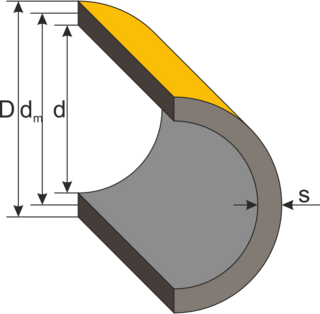 W
WBarlow's formula relates the internal pressure that a pipe can withstand to its dimensions and the strength of its material. This approximate formula is named after Peter Barlow, an English mathematician.Cylinder,
 W
WCement-mortar lined ductile iron pipe is a ductile iron pipe with cement lining on the inside surface, and is commonly used for water distribution.
 W
WA concentric reducer is used to join pipe sections or tube sections on the same axis. The concentric reducer is cone-shaped, and is used when there is a shift in diameter between pipes. For example, when a 1" pipe transitions into a 3/4" pipe and the top or bottom of the pipe doesn't need to remain level. This pipe reducer may be used when there is a single diameter change or multiple diameter changes.
 W
WA coupling is a very short length of pipe or tube, with a socket at one or both ends that allows two pipes or tubes to be joined, welded (steel), brazed or soldered together.
 W
WA cured-in-place pipe (CIPP) is a trenchless rehabilitation method used to repair existing pipelines. It is a jointless, seamless pipe lining within an existing pipe. As one of the most widely used rehabilitation methods, CIPP has applications in sewer, water, gas, and chemical pipelines ranging in diameter from 0.1 to 2.8 meters.
 W
WDrill pipe, is hollow, thin-walled, steel or aluminium alloy piping that is used on drilling rigs. It is hollow to allow drilling fluid to be pumped down the hole through the bit and back up the annulus. It comes in a variety of sizes, strengths, and wall thicknesses, but is typically 27 to 32 feet in length. Longer lengths, up to 45 feet, exist.
 W
WDuctile iron pipe is pipe made of ductile cast iron commonly used for potable water transmission and distribution. This type of pipe is a direct development of earlier cast iron pipe, which it has superseded. The ductile iron used to manufacture the pipe is characterized by the spheroidal or nodular nature of the graphite within the iron. Typically, the pipe is manufactured using centrifugal casting in metal or resin lined moulds. Protective internal linings and external coatings are often applied to ductile iron pipes to inhibit corrosion: the standard internal lining is cement mortar and standard external coatings include bonded zinc, asphalt or water-based paint. In highly corrosive environments loose polyethylene sleeving (LPS) to encase the pipe may also be used. Life expectancy of unprotected ductile iron pipes depends on the corrosiveness of soil present and tends to be shorter where soil is highly corrosive. However, a lifespan in excess of 100 years has been estimated for ductile iron pipelines installed using "evolved laying practices", including use of properly installed LPS. Studies of ductile iron pipe's environmental impact have differing findings regarding emissions and energy consumed. Ductile iron pipe manufactured in the United States has been certified as a sustainable product by the Institute for Market Transformation to Sustainability.
 W
WThe word electrofusion is also used when fusing cells with electricity.
 W
WAn expansion joint or movement joint is an assembly designed to hold parts together while safely absorbing temperature-induced expansion and contraction of building materials, and vibration, or to allow movement due to ground settlement or seismic activity. They are commonly found between sections of buildings, bridges, sidewalks, railway tracks, piping systems, ships, and other structures.
 W
WA fire sprinkler system is an active fire protection method, consisting of a water supply system, providing adequate pressure and flowrate to a water distribution piping system, onto which fire sprinklers are connected. Although historically only used in factories and large commercial buildings, systems for homes and small buildings are now available at a cost-effective price. Fire sprinkler systems are extensively used worldwide, with over 40 million sprinkler heads fitted each year. Even though Fire Sprinkler Systems are a Life Saving System and are not designed to protect the building, 96% of buildings that had fires and were completely protected by fire sprinkler systems were controlled by the fire sprinklers alone.
 W
WA pipefitter or steamfitter is a tradesperson who installs, assembles, fabricates, maintains, and repairs mechanical piping systems. Pipefitters usually begin as helpers or apprentices. Journeyman pipefitters deal with industrial/commercial/marine piping and heating/cooling systems. Typical industrial process pipe is under high pressure, which requires metals such as carbon steel, stainless steel, and many different alloy metals fused together through precise cutting, threading, grooving, bending, and welding. A plumber concentrates on lower pressure piping systems for sewage and potable tap water in the industrial, commercial, institutional, or residential atmosphere. Utility piping typically consists of copper, PVC, CPVC, polyethylene, and galvanized pipe, which is typically glued, soldered, or threaded. Other types of piping systems include steam, ventilation, hydraulics, chemicals, fuel, and oil.
 W
WA flange is a protruded ridge, lip or rim, either external or internal, that serves to increase strength ; for easy attachment/transfer of contact force with another object ; or for stabilizing and guiding the movements of a machine or its parts. The term "flange" is also used for a kind of tool used to form flanges.
 W
WIn physics and engineering, fluid dynamics is a subdiscipline of fluid mechanics that describes the flow of fluids—liquids and gases. It has several subdisciplines, including aerodynamics and hydrodynamics. Fluid dynamics has a wide range of applications, including calculating forces and moments on aircraft, determining the mass flow rate of petroleum through pipelines, predicting weather patterns, understanding nebulae in interstellar space and modelling fission weapon detonation.
 W
WIn fluid flow, friction loss is the loss of pressure or “head” that occurs in pipe or duct flow due to the effect of the fluid's viscosity near the surface of the pipe or duct. In mechanical systems such as internal combustion engines, the term refers to the power lost in overcoming the friction between two moving surfaces, a different phenomenon.
 W
WA globe valve, different from ball valve, is a type of valve used for regulating flow in a pipeline, consisting of a movable plug or disc element and a stationary ring seat in a generally spherical body.
 W
WA gooseneck is a 180° pipe fitting at the top of a vertical pipe that prevents entry of water. Common implementations of goosenecks are ventilator piping or ducting for bathroom and kitchen exhaust fans, ship holds, landfill methane vent pipes, or any other piping implementation exposed to the weather where water ingress would be undesired. It is so named because the word comes from the similarity of pipe fitting to the bend in a goose's neck.
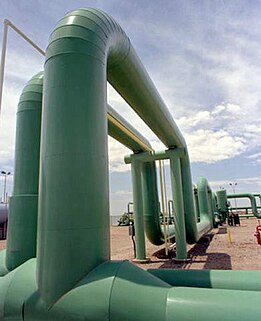 W
WHydrogen pipeline transport is a transportation of hydrogen through a pipe as part of the hydrogen infrastructure.
 W
WA hydrostatic test is a way in which pressure vessels such as pipelines, plumbing, gas cylinders, boilers and fuel tanks can be tested for strength and leaks. The test involves filling the vessel or pipe system with a liquid, usually water, which may be dyed to aid in visual leak detection, and pressurization of the vessel to the specified test pressure. Pressure tightness can be tested by shutting off the supply valve and observing whether there is a pressure loss. The location of a leak can be visually identified more easily if the water contains a colorant. Strength is usually tested by measuring permanent deformation of the container. Hydrostatic testing is the most common method employed for testing pipes and pressure vessels. Using this test helps maintain safety standards and durability of a vessel over time. Newly manufactured pieces are initially qualified using the hydrostatic test. They are then revalidated at regular intervals according to the relevant standard. In some cases where a hydrostatic test is not practicable a pneumatic pressure test may be an acceptable alternative. Testing of pressure vessels for transport and storage of gases is very important because such containers can explode if they fail under pressure.
 W
WInsulated pipes are widely used for district heating and hot water supply in Europe. They consist of a steel pipe, an insulating layer, and an outer casing. The main purpose of such pipes is to maintain the temperature of the fluid in the pipes. A common application is the hot water from district heating plants. Most commonly used are single insulated pipes, but more recently in Europe it is becoming popular to use two pipes insulated within the same casing. By using insulated pipe supports, direct heat transfer between pipes and their supports are prevented.
 W
WJIC fittings, defined by the SAE J514 and MIL-DTL-18866 standards, are a type of flare fitting machined with a 37-degree flare seating surface. JIC fittings are widely used in fuel delivery and fluid power applications, especially where high pressure is involved. The SAE J514 standard replaces the MS16142 military specification, although some tooling is still listed under MS16142. JIC fittings are dimensionally identical to AN (Army-Navy) fittings, but are produced to less exacting tolerances and are generally less costly. SAE 45-degree flare fittings are similar in appearance, but are not interchangeable, though dash sizes 2, 3, 4, 5, 8, 10, 14, and 16 share the same thread size. Some couplings may have dual machined seats for both 37-degree and 45-degree flare seats. Komatsu and JIS fittings have flare ends similar to JIC fittings. Komatsu and JIS both use a 30-degree flare seating surface. The only difference is Komatsu uses millimeter thread sizes while JIS use a BSP thread. JIC fitting systems have three components that make a tubing assembly: fitting, flare nut, and sleeve. As with other flared connection systems, the seal is achieved through metal-to-metal contact between the finished surface of the fitting nose and the inside diameter of the flared tubing. The sleeve is used to evenly distribute the compressive forces of the flare nut to the flared end of the tube. Materials commonly used to fabricate JIC fittings include forged carbon steel, forged stainless steel, forged brass, machined brass, Monel and nickel-copper alloys.
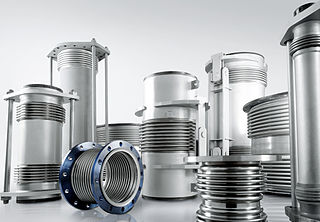 W
WMetal expansion joints are compensating elements for thermal expansion and relative movement in pipelines, containers and machines. They consist of one or more metal bellows, connectors at both ends, and tie rods that depend on the application. They are differentiated according to the three basic types of movement: axial, angular and lateral expansion joints. Expansion joints have usage in various sectors, like energy productions, paper industry, chemical industry, water treatment, oil and gas. Everywhere where exist pipelines and occurs thermal movements or vibration, then expansion joints can be used.
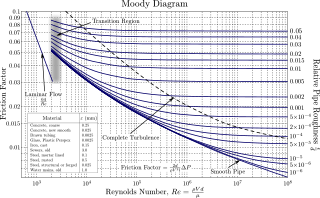 W
WIn engineering, the Moody chart or Moody diagram is a graph in non-dimensional form that relates the Darcy–Weisbach friction factor fD, Reynolds number Re, and surface roughness for fully developed flow in a circular pipe. It can be used to predict pressure drop or flow rate down such a pipe.
 W
WAmerican National Standard Pipe Thread standards, often called national pipe thread standards for short, are U.S. national technical standards for screw threads used on threaded pipes and pipe fittings. They include both tapered and straight thread series for various purposes, including rigidity, pressure-tight sealing, or both. The types are named with a symbol and a full name. Examples of the symbols include NPT, NPS, NPTF, NPSC.
 W
WIn plumbing and piping, a nipple is a fitting, consisting of a short piece of pipe, usually provided with a male pipe thread at each end, for connecting two other fittings.
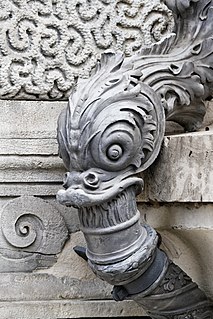 W
WA pipe is a tubular section or hollow cylinder, usually but not necessarily of circular cross-section, used mainly to convey substances which can flow — liquids and gases (fluids), slurries, powders and masses of small solids. It can also be used for structural applications; hollow pipe is far stiffer per unit weight than solid members.
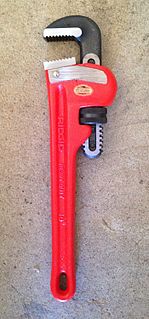 W
WA pipe wrench is any of several types of wrench that are designed to turn threaded pipe and pipe fittings for assembly (tightening) or disassembly (loosening). The Stillson wrench, or Stillson-pattern wrench, is the usual form of pipe wrench, especially in North America. The Stillson name is that of the original patent holder, who licensed the design to a number of manufacturers. The patent expired decades ago. Another type of wrench often used on pipes, the plumber wrench, is also called a pipe wrench in some places.
 W
WPipeline transport is the long-distance transportation of a liquid or gas through a system of pipes—a pipeline—typically to a market area for consumption. The latest data from 2014 gives a total of slightly less than 2,175,000 miles (3,500,000 km) of pipeline in 120 countries of the world. The United States had 65%, Russia had 8%, and Canada had 3%, thus 75% of all pipeline were in these three countries.
 W
WA fitting or adapter is used in pipe systems to connect straight sections of pipe or tube, adapt to different sizes or shapes, and for other purposes such as regulating fluid flow. These fittings are used in plumbing to manipulate the conveyance of water, gas, or liquid waste in domestic or commercial environments, within a system of pipes or tubes.
 W
WPlastic pipe is a tubular section, or hollow cylinder, made of plastic. It is usually, but not necessarily, of circular cross-section, used mainly to convey substances which can flow—liquids and gases (fluids), slurries, powders and masses of small solids. It can also be used for structural applications; hollow pipes are far stiffer per unit weight than solid members.
 W
WA plug in sanitation is an object that is used to close a drainage outlet firmly.
 W
WA relief valve or pressure relief valve (PRV) is a type of safety valve used to control or limit the pressure in a system; pressure might otherwise build up and create a process upset, instrument or equipment failure, or fire. The pressure is relieved by allowing the pressurized fluid to flow from an auxiliary passage out of the system. The relief valve is designed or set to open at a predetermined set pressure to protect pressure vessels and other equipment from being subjected to pressures that exceed their design limits. When the set pressure is exceeded, the relief valve becomes the "path of least resistance" as the valve is forced open and a portion of the fluid is diverted through the auxiliary route. In systems containing flammable fluids, the diverted fluid is usually routed through a piping system known as a flare header or relief header to a central, elevated gas flare where it is usually burned and the resulting combustion gases are released to the atmosphere. In non-hazardous systems, the fluid is often discharged to the atmosphere by a suitable discharge pipework designed to prevent rainwater ingress which can affect the set lift pressure, and positioned not to cause a hazard to personnel. As the fluid is diverted, the pressure inside the vessel will stop rising. Once it reaches the valve's reseating pressure, the valve will close. The blowdown is usually stated as a percentage of set pressure and refers to how much the pressure needs to drop before the valve reseats. The blowdown can vary roughly 2–20%, and some valves have adjustable blowdowns.
 W
WThe Reynolds number helps predict flow patterns in different fluid flow situations. At low Reynolds numbers, flows tend to be dominated by laminar (sheet-like) flow, while at high Reynolds numbers flows tend to be turbulent. The turbulence results from differences in the fluid's speed and direction, which may sometimes intersect or even move counter to the overall direction of the flow. These eddy currents begin to churn the flow, using up energy in the process, which for liquids increases the chances of cavitation. Reynolds numbers are an important dimensionless quantity in fluid mechanics.
 W
WA Riser clamp is a type of hardware used by mechanical building trades for pipe support in vertical runs of piping (risers) at each floor level. The devices are placed around the pipe and integral fasteners are then tightened to clamp them onto the pipe. The friction between the pipe and riser clamp transfers the weight of the pipe through the riser clamp to the building structure. Risers are generally located at floor penetrations, particularly for continuous floor slabs such as concrete. They may also be located at some other interval as dictated by local building codes or at intermediate intervals to support plumbing which has been altered or repaired. Heavier piping types such as cast iron require more frequent support. Ordinarily, riser clamps are made of carbon steel and individually sized to fit certain pipe sizes. "Riser" refers to vertical runs of pipes, electrical conduit and tubes.
 W
WA rupture disk, also known as a pressure safety disc, burst disc, bursting disc, or burst diaphragm, is a non-reclosing pressure relief safety device that, in most uses, protects a pressure vessel, equipment or system from overpressurization or potentially damaging vacuum conditions.
 W
WIn construction, a sleeve is used both by the electrical and mechanical trades to create a penetration.
 W
WSprinkler fitting is an occupation consisting of the installing, testing, inspecting, and certifying of automatic fire suppression systems in all types of structures. Sprinkler systems installed by sprinkler fitters can include the underground supply as well as integrated overhead piping systems and standpipes. The fire suppression piping may contain water, air, antifreeze, gas or chemicals as in a hood system, or a mixture producing fire retardant foam.
 W
WIn North America, a standpipe is a type of rigid water piping which is built into multi-story buildings in a vertical position, or into bridges in a horizontal position, to which fire hoses can be connected, allowing manual application of water to the fire. Within the context of a building or bridge, a standpipe serves the same purpose as a fire hydrant.
 W
WA static mixer is a precision engineered device for the continuous mixing of fluid materials, without moving components. Normally the fluids to be mixed are liquid, but static mixers can also be used to mix gas streams, disperse gas into liquid or blend immiscible liquids. The energy needed for mixing comes from a loss in pressure as fluids flow through the static mixer. One design of static mixer is the plate-type mixer and another common device type consists of mixer elements contained in a cylindrical (tube) or squared housing. Mixer size can vary from about 6 mm to 6 meters diameter. Typical construction materials for static mixer components include stainless steel, polypropylene, Teflon, PVDF, PVC, CPVC and polyacetal. The latest designs involve static mixing elements made of glass-lined steel.
 W
WA thread protector is used to protect the threads of a pipe during transportation and storage. Thread protectors are generally manufactured from plastic or steel and can be applied to the pipe manually or automatically.
 W
WA threaded pipe is a pipe with screw-threaded ends for assembly.
 W
WElectric heat tracing, heat tape or surface heating, is a system used to maintain or raise the temperature of pipes and vessels using heat tracing cables. Trace heating takes the form of an electrical heating element run in physical contact along the length of a pipe. The pipe is usually covered with thermal insulation to retain heat losses from the pipe. Heat generated by the element then maintains the temperature of the pipe. Trace heating may be used to protect pipes from freezing, to maintain a constant flow temperature in hot water systems, or to maintain process temperatures for piping that must transport substances that solidify at ambient temperatures. Electric trace heating cables are an alternative to steam trace heating where steam is unavailable or unwanted.
 W
WIn plumbing, a trap is a U-shaped portion of pipe designed to trap liquid or gas to prevent unwanted flow; most notably sewer gases from entering buildings while allowing waste materials to pass through. In oil refineries, traps are used to prevent hydrocarbons and other dangerous gases and chemical fumes from escaping through drains. In heating systems, the same feature is used to prevent thermo-siphoning which would allow heat to escape to locations where it is not wanted. Similarly, some pressure gauges are connected to systems using U bends to maintain a local gas while the system uses liquid. For decorative effect, they can be disguised as complete loops of pipe, creating more than one U for added efficacy.
 W
WA tube, or tubing, is a long hollow cylinder used for moving fluids or to protect electrical or optical cables and wires.
 W
WTube bending is any metal forming processes used to permanently form pipes or tubing. Tube bending may be form-bound or use freeform-bending procedures, and it may use heat supported or cold forming procedures.
 W
WThe tubular pinch effect is a phenomenon in fluid mechanics, which has importance in membrane technology. This effect describes a tendency for suspended particles flowing through a pipe to reach an equilibrium distribution with the region of highest concentration of particles lies between the central axis and the wall of the pipe.
 W
WA valve is a device or natural object that regulates, directs or controls the flow of a fluid by opening, closing, or partially obstructing various passageways. Valves are technically fittings, but are usually discussed as a separate category. In an open valve, fluid flows in a direction from higher pressure to lower pressure. The word is derived from the Latin valva, the moving part of a door, in turn from volvere, to turn, roll.